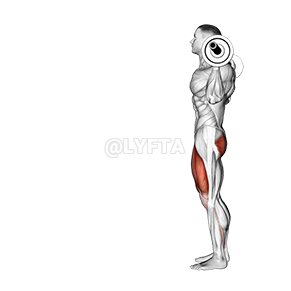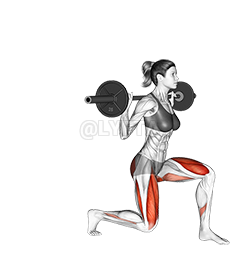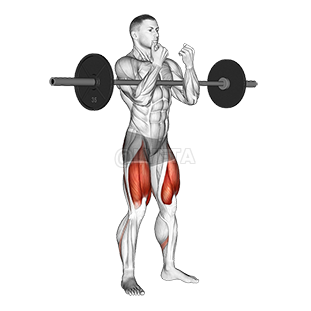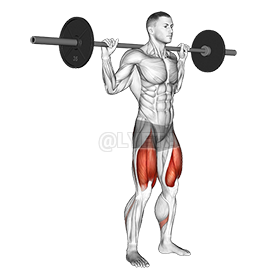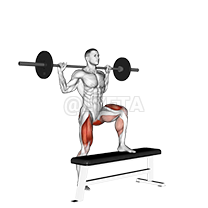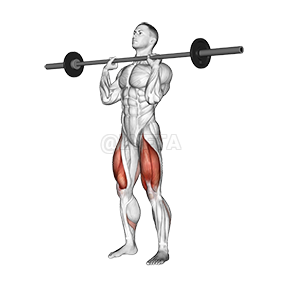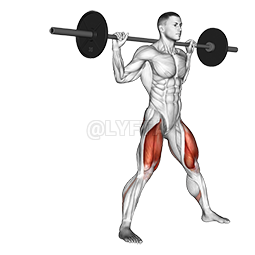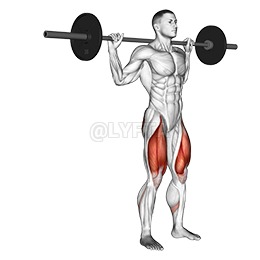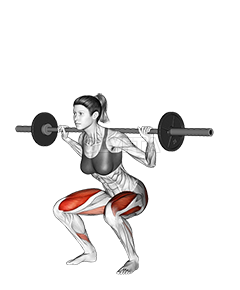
Low Bar Squat
Exercise Profile
Related Exercises:
Introduction to the Low Bar Squat
The Low Bar Squat is a strength-building exercise that primarily targets the muscles of the lower body, including the glutes, hamstrings, and quadriceps, while also engaging the core and back. This workout is perfect for weightlifters, athletes, or anyone looking to build lower body strength and improve overall fitness. Individuals may choose to incorporate Low Bar Squats into their routine due to its effectiveness in building muscle mass, improving mobility, and enhancing athletic performance.
Performing the: A Step-by-Step Tutorial Low Bar Squat
- Stand with your feet shoulder-width apart, toes slightly pointed outwards, and brace your core.
- Begin the movement by pushing your hips back, bending at the knees and lowering your body as if you're sitting back into a chair, ensuring that your knees do not go past your toes.
- Lower your body until your thighs are parallel to the floor, or as far as you can comfortably go while keeping your back straight.
- Push through your heels to stand back up to the starting position, making sure to keep your back straight and your core engaged throughout the entire movement.
Tips for Performing Low Bar Squat
- **Foot Placement and Movement**: Your feet should be shoulder-width apart, with your toes angled slightly outward. When squatting, avoid allowing your knees to cave inward. Instead, try to push your knees out in the direction of your toes. This will help engage the right muscles and protect your knees from potential injury.
- **Maintain a Neutral Spine**: To avoid injuries, it's crucial to maintain a neutral spine throughout the movement. Don't round your back or over-arch it. Engage your core to help keep your back straight and to provide stability.
- **Proper Breathing Technique**: Breathing is often overlooked but is essential
Low Bar Squat FAQs
Can beginners do the Low Bar Squat?
Yes, beginners can definitely do the Low Bar Squat exercise. However, it's important to start with light weights or even just the barbell to get used to the movement and form. It is also beneficial to have someone experienced, like a personal trainer, to guide through the correct form to avoid any potential injuries. Always remember, proper form and technique are more important than lifting heavy weights, especially for beginners.
What are common variations of the Low Bar Squat?
- Front Squat: The barbell is held in front of the body across the deltoids, shifting focus to the quads and upper back.
- Box Squat: This involves squatting down to a box or bench before standing back up, which can help improve form and target different muscle groups.
- Zercher Squat: In this variation, the barbell is held in the crook of the elbows, challenging the core and upper body strength.
- Overhead Squat: Here, the barbell is held overhead throughout the entire movement, which requires and improves balance, mobility, and core strength.
What are good complementing exercises for the Low Bar Squat?
- Front squats can be a beneficial addition to your routine because they shift more of the focus to the quadriceps, providing a balanced leg strength development when combined with the hamstring and glute focus of Low Bar Squats.
- Lunges, particularly walking lunges, complement Low Bar Squats by targeting the quadriceps, glutes, and hamstrings, while also improving balance and stability, which can enhance your overall squat performance.
Related keywords for Low Bar Squat
- Low Bar Squat technique
- Barbell Squat workouts
- Quadriceps strengthening exercises
- Thigh muscle building
- Barbell exercises for thighs
- Low Bar Squat form
- Lower body workouts with barbell
- Barbell squats for quadriceps
- How to do Low Bar Squat
- Strength training for thighs
